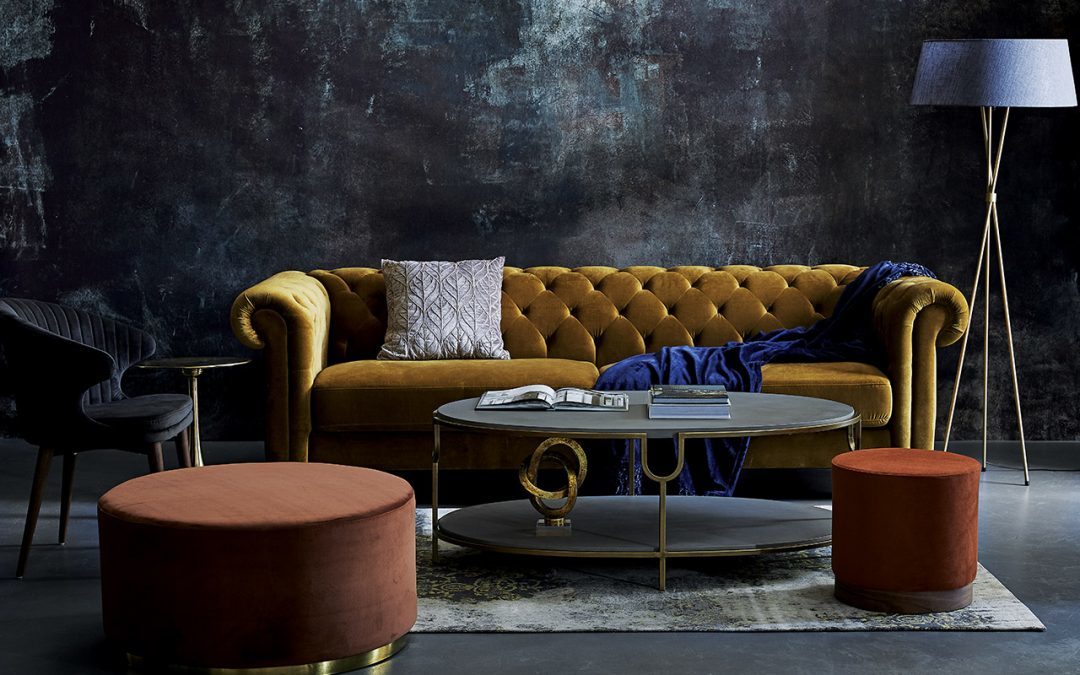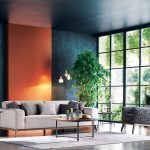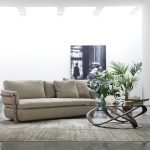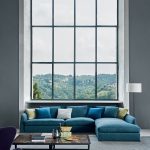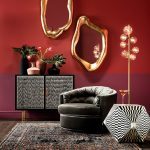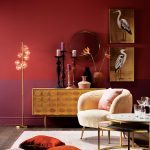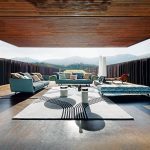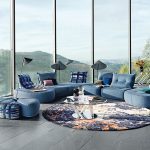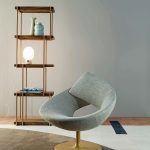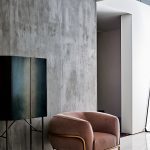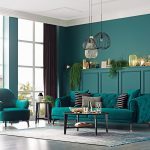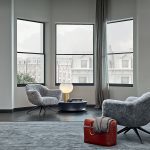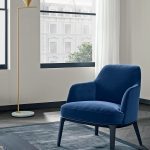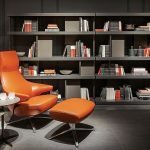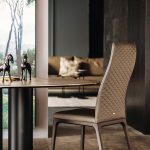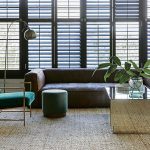The pursuit of relaxation has become especially necessary in the current South African environment. For most of us in our residential lifestyles, chilling out and kicking back is an essential affair. Cover image by @home
In this, Habitat’s annual FOCUS feature on contemporary seating and upholstery, we showcase the ever widening scale of choice in South Africa’s major centres. As is our established direction, designers and manufacturers provide foretelling opinions on both local and international trends.
It’s accepted that a positive seating solution incorporates two elements: aesthetics and comfort; and that the latter involves ergonomics. This is a best of both worlds scenario and ideally the result should conjure a contemporary statement, yet without fashionable additives and decorative confectionary.
- Enza Home
Today’s sofas, unit seating systems, comfortable occasional chairs and recliners are often favourite pieces – almost cherished. Their arrangements are sited in areas where families and singles relax, eat meals, use digital devices and even work. We humans of all ages, doze and recline, or even lay down, very often contemplating screens of various dimensions. We have been digitalised at home and are now being seated to suit what has become a rapidly changing lifestyle.
Italian manufacturer Porada adds comment on behalf of SA agents maldini about looks and trends for 2019: ‘Domestic environments are designed with the idea of a personal, secure place in which to recover from daily stress and digital overwhelming. This current direction is highly influencing the furniture and interior field as the space – and each piece contained within – must welcome and accommodate. Therefore, seats are soft, oversized, enclosing.
- Porada for maldini
‘Again, linking to our need for well-being and sustainability and in opposition to the over-digitalisation of daily tasks, fabrics (and actually materials in general) are characterised by surfaces that are of tactile interest, such as embroidered textiles, wool bouclé, tweed, linen, organic cotton and other weaves with a 3D / embossed texture. A particular case is that of vegetable-derived leather and suede: there has been, for example, some experimentation with apple-based leather, miming the evergreen upholstery material, but as a sustainable option.’
Bearing this in mind, and waving the banner for modernism, Habitat champions contemporary furniture: line and form that rejects conformity and interrogates both style and function; if not multifunction.
What is most relevant in contemporary seating, and its fit in current living spaces?
‘Sofas are of course the main player in the living room, the space where we humans spend most of our time, and we’re seeing a strong return to comfort as the main element of any sofa,’ so says Aldon McLeod of True Design, ‘Colourways are becoming defiantly dramatic: deep greens, yellows and burgundy; with an alternative of soft patterns – very Japanese – i.e. futon and printed linens with Ikebana graphics. Softness is taking centre stage, it’s a move back towards feel and comfort with leathers being non-pressed and more natural pelle hides.’
Raffaela Marelli gives other examples on behalf of Flexform / Il Lusso: ‘The aura that envelops the Flexform Mood collection is intimate and sophisticated. It features sofas and armchairs that show traditional stylistic shapes redesigned with a contemporary twist. The Alfred sofa, designed by Roberto Lazzeroni, perfectly epitomises this attitude in conveying a typically ‘New Classic’ flair. Its enveloping seat back curves around, sloping gently from the armrest. Couture details highlight the soft silhouette and the seat back, and cushions are finished with refined tone-on-tone or contrasting colour grosgrain piping.’
- Flexform for Il Lusso
Karin Cawthorne of interior decorators and designers KARE says: ‘We’re seeing many contemporary designs paying homage to the original modern masters such as Anni and Josef Albers and Le Corbusier, with their modernist use of timber and metal employed in clean lines. As regards shapes, sumptuous and generous curves are on trend, probably aroused by the aesthetics of the 1970s, and are most prominent in back and arm rests.
‘More metal is being used, particularly in the frames and legs of armchairs, barstools and dining chairs. Metals are moving more towards the brass and gold spectrum, whilst black or blackened metal is making a powerful impact as the go-to finish. In contrast, we’ve also noted the influence timber and bamboo are having on interiors; materials that provide warmth and an endearing natural feel that juxtaposes metal accents effectively.’
In line with this direction, Habitat’s research indicates that 2019 should see a continuing movement towards more natural fabrics and materials. These may be used throughout contemporary interiors on cushions and for upholstery; and could be signifying a step away from the flashy modern handwriting – or the overtly clinical – and more towards natural, inviting décor. Such is the case with Hygge, the Danish obsession with invoking a quality of cosiness and comfortable conviviality that has gained positive traction globally.
- KARE
- KARE
Karin Cawthorne adds: ‘A noted trend in seating is a move towards handmade and artisanal chairs and sofas that offer a sense of authenticity for today’s interiors. This is achieved using interesting crafting techniques such as carving, forging, weaving and unusual upholstery methods. Fabric-wise, natural fibres such as cotton, linen and silk remain popular whilst the advancements in environmentally progressive textiles, such as hemp and bamboo, are making a strong impact on interiors for both their aesthetic and hypoallergenic and antibacterial benefits. Raffia, cane and rattan are also strong trends in seating, with the repeat geometric patterns and texture adding to the creation of well balanced interiors. Deep-buttoning, quilting, piping and the weaving of strips of fabric, rope and leather remain popular in terms of upholstery techniques.’
This appreciation for natural materials and softer tones is already evident with an increase in the demand for warm textures across the storyboard; knits and weaves are seen in upholstery, cushions and throws. Pleats, embroidery and raw fabric edges also confirm the cosy, home base feel. Viva Hygge! – particularly with winter on the way
in SA.
Such natural fabrics and textures are able to complement diverse styles from Scandinavian to French country, but take note that mid-century modern isn’t going away. It’s timeless and in 2019 we’re likely to see more of it in those forever classical chairs and sofas. Its international usage in both residential and hostelry interior design is as a result of an easy fit for a range of décor themes.
So, it’s a given that mid-century modern has made a lasting impact for good reason. Certain of the pieces, designed for the legendary 1929 Barcelona World Fair, are still regarded as ‘modern’ today because they were so well conceived and engineered by architects and designers who embraced the new ‘industrial age’ materials, discovering innovative ways of using them. The results are designs that may be regarded as the ‘antiques of the future’: the progeny of those visionaries of the Bauhaus era.
- Carl Hansen by DOMUM – Huntsman Chair
As with mid-century modern and Bauhaus, the interior design space has always appreciated the art deco style, and design gurus globally are hinting at the potential for art deco returning as a major trend. We expect to see it in not just random designs, but evident in the detailing of a variety of furniture from chairs to sofas. And with the move towards urban city dwelling, art deco – and also retro inspiration – remain visible in more elegant, movable furniture set-ups in modern urban homes. It’s undoubtedly out there as a possible glamorous focal point.
‘We expect the art deco influence to become more prominent in the coming year, inspiring both textile design and furniture silhouettes. From a colour perspective, pink continues to be very strong in furniture. Given that, we expect shades that complement the blush hue to do very well; specifically, olive green, oxblood, and navy.’ – Meganne Wecker, founder of Cloth & Company.
Following on from these modern classics, this year should also see a continuous gravitation towards a more curvaceous design aesthetic. Top designers globally list this as a potential trend seen in synch with bolder colours: navy blue, citrine and forest green, with an added sense of whimsy that informs a shift away from the rectilinear.
‘In 2019, we should embrace a curvy design aesthetic; ‘70s-inspired rounded furniture will see increased popularity. Rounded back chairs are a chic way to bring curvaceous form into the home.’ – Anne Hepfer, interior designer.
Sandrine Fanchette of Roche Bobois agrees: ‘The trend for 2019 is all about curves, indeed, curved sofas and enveloping tub chairs are among the latest pieces. The Dot and Walrus armchairs and Ondea sofa are good examples of this manifest trend. However, a rectangular linear profile remains a safe, non-trend choice in creating timeless ambiance in a living room: the Mah Jong sofa, which is a signature model since 1970, is proof of this. In addition, there is a move towards large and dramatic pieces that will introduce more character to an interior. An example is the impressive Mongolfiere sofa and armchairs by Marcel Wanders for Roche Bobois.’
- Roche Bobois
Upholstery-wise, velvet and suede fabrics have never really faded away. Although they’ve featured slightly less in the past few years, their use remains a definitive look that makes a significant impact on a variety of pieces; as an across-the-board upholstery fabric choice. Our research indicated an increased demand for velvets towards the end of 2018, likely due to their tactility in offering both comfort and fancy on certain particularly alluring pieces of furniture.
What are the indications colour-wise?
Sandrine Fanchette: ‘The most recent colour tones are indubitably bold: navy blue, dark green, deep red and burnt orange are virtually going viral. We also note that natural, feminine colours such as bronze, blush and light grey are up there currently. In terms of both textures and pattern motifs, the wallpaper effect is much demanded; it’s the very reason why Marcel Wanders exclusively designed the Globe Trotter fresco fabrics around three city themes: Paris, London, and Istanbul.’
- Roche Bobois
‘Flexform’s Mood fabric collection plays with soft shades of grey and beige, mingled with deep tones of blue,’ says Raffaela Marelli. ‘The suggestion for the large surface of a sectional sofa is to go with the timeless yet chic choice of a plain but sophisticated colour and add cushions in contrasting tones in order to introduce a decorative accent. We love deep blue to be juxtaposed with white and lime yellow fabrics and also suggest a play of different textures. If the sofa is covered in canvas, the cushions might well be in velvet or cashmere.’
Space to Place
In terms of residential functionality, the trend towards aesthetics, smartness and adaptability continues to blaze through the interior design and decoration sector globally. It should dictate the emergence of diverse choices in fascinating multipurpose furnishings, with variable compact seating being at the fore in more demanding spaces. Increasingly, in major centres internationally, the ‘one room’ scenario is being driven by the need for multifunctional living, dining rooms being seldom used things of the past.
‘Life feels uncertain and chaotic right now. We are hearing more and more that our clients want to simplify their homes and interiors. To that end, we believe we will be seeing more multifunctional furniture in 2019.’ – Kristen Pena, interior designer.
It’s a fact that space for both residential and corporate interior projects shrinks annually as populations in cities escalate – and SA follows this trend. As a result, the various seating requirements of an increasingly informed end user should promote better domestic and working space. But, as ever, the achievement of aesthetic arrangements with both visual and tactile appeal – linked to maximum comfort – is often a compromise involving both the space available and the budget.
‘Trends this season include mechanisms, motions and movement. They manifest in more and better functionality; such as sofas that mould into a chaise, and armchairs that swivel,’ says Tracy-Lee Gradidge of interior specialists Casarredo, who analyses further, ‘We see contemporary seating for 2019 represented by a Scandinavian luxe style with simple and elegant lines and homage paid to the environment. Classic luxury is now becoming modern luxury; we are seeing less fussiness and the designing of exceptionally sculptured furniture that makes an impression on its own, without having to over accessorise.
- Casarredo
- Casarredo
‘Globally, pink is still a big player evident in pastels and recently animal prints, from giraffe to lynx. Grey remains the base colour and grounding of many storyboards, but interesting combinations added this season include paprika, mustard yellow, burgundy and military greens, all juxtaposed by ivory whites.
‘Stitching and personalising is key to making a sofa or armchair unique and original. 2019 fabric trends include elegantly stitched detailing executed by special machinery with threads in different colours and of varying thicknesses; plus full grain leather with Aniline finishing and fringe detailing is also in evidence. We use only premium leather hides on upholstered sofas, armchairs, furnishings and accessories; up to 4.5mm thick, these large hides mainly originate from Italy and Northern Europe.’
‘Small details in upholstery have a big impact on design. Seams can pack a punch. Contrast piping, contrast stitching, and flanged seams used individually create uniqueness and a level of perceived value.’ – Rob Royer, CEO of Interior Define.
Azeem Khan from House & Haven offers more on 2019 trends: ‘Contemporary style refers to strong visible linearity, that can be vertical, horizontal or rounded as opposed to the overtly stark lines seen in modern design. Trends include clean, luxurious sofas where less is more – and chairs that are bold and unique like a round swivel loveseat with metal trim. The look is simple and uncluttered, but at the same time makes bold statements.
- House & Haven
‘Such pieces will be seen in neutral colours with natural textures: wools, cottons, linens, silks and aged leathers are big this year while blacks, whites, greys and beiges allow for a neutral palette to build on. Plain and textured velvets are still here and accessorising with bold colours and patterns allows for changes in interior looks by the season.
‘Geometric patterns are again on trend, as is the mixing of fabrics on sofas and chairs to create depth and a more textured look. The new Fibreguard fabrics are great for informal lounge sofas as an alternative to leather, and yet aged leather with a mottled appearance is a current trend that will likely remain timeless. Thick double stitching on leather and piping in darker tones is taking the ordinary to the extraordinary this year.’
In 2019, it’s vital to ensure that while furniture may reflect an ever evolving lifestyle, it should remain comfortable and welcoming. Seating arrangements chosen should be not only aesthetically pleasing but also ergonomically designed to support the human frame as far as possible and in whatever position the piece dictates; last to consider is the ecological impact of the materials chosen for the construction of such seating.
At the high end, today’s contemporary classics in chairs and sofas represent a considerable investment and consequently should retain their longevity, of both look and value. The most renowned examples will surely therefore become more widely regarded as timeless classics, as did their forebears.
Zubair Garda of Enza Home on today’s sofas and their upholstery: ‘Everyday furniture pieces become works of art, have more functional features and provide a place in which to spend more time. Traditional upholstery is becoming exaggerated via excessive prints and bold proportions – a key trend for 2019. Techniques are now being modernised with graphic forms, such as new directions for buttoning, pleating and folding fabrics. Sofa-scapes create artistic compositions in larger living spaces and designs are sophisticated with refined lines and sharp silhouettes.
- Enza Home
‘Elsewhere, plump and inflated forms add a sense of comfort and relaxation, encouraging consumers to unwind and lounge. Voluminous structures create a soothing, cosy and inviting feel in both hard and soft materials. Inflated features welcome a playful essence with a cocooning and nesting sensation, while quilted and overstuffed upholstery combines with softly curved edges. Shapes are simple and minimal, with the focus on infused block tones, and forms can be teamed with uncomplicated wirework, creating space around the shape.
‘Upholstery fabric-wise, lines are offset with stripes and geometric shapes in random compositions. The interplay of positive and negative space creates a sense of volume in fabrics where designs are enlivened with a combination of soft and bold accents. The imperfections of nature inspire textured, tactile surfaces, and embroideries that mimic the look of corrosion are used to coat shantung weaves, and mixed linen wools are crushed for a pre-used appearance. Dévoré velvets highlight a contrast between muted and high-shine yarns, and seersucker and crumpling techniques add a rustic quality to collections.
‘Thick and fine yarns feature everything from soft wools to chunky leathers, and cushions and throws show overlaid thread effects, which add tactility. Multicoloured and woven textiles are just as good when reversed, and a similar and more cost-effective look can be created with print. Jacquard velours feature contrasting colours and textures, and woven textiles mix geometric elements in scattered formations, creating busy, vibrant patterns. Maze-like repeat patterns are also seen, and stripes and blocks are mismatched or spliced. Faux leathers like Nubuck, and suedes remain popular, as do velvets.’
- Poliform
- Poliform
Italy, Germany, France, UK and Scandinavia are home to long established furniture manufacturers of high repute. Today, this is where globally renowned designers continue to work with vision and singular purpose to create outstanding collections; many of which appear in Habitat. Annual R&D in this upper echelon sector stretches the design envelope with new materials, sculpted forms and innovative functionality. The result is all that could be wished for. Frames and support systems have added strength, but are lighter with reduced mass; seats – and the upholstery that clads them – look and feel better.
George Georgio of Poltrona Frau comments on leather for upholstery: ‘The function of human seating is not only limited to residential and corporate interiors. All the millennial principles imaginable are reflected in Poltrona Frau’s history of leatherwork, which reads like a list of very fine perches: first-class cabin recliners for Etihad Airways and Singapore Airlines, upholstery for BMW, Maserati and Ferrari, plus Pershing and Arcadia Super Yachts. All such partner projects rely on Poltrona Frau’s Pelle Frau® aviation leather, which has been developed to meet rigorous international standards in this sector and is offered in 96 colours; bespoke shades that allow for theoretically limitless colour options.
- Poltrona Frau
‘This artisanal / craftsman perfection is the very DNA of all Poltrona Frau seating and – because appearance is of the utmost importance – the company offers various design options. For example, seats can be plain or two-toned and leathers can equally match or contrast with the seats. As a result of a high emphasis on ultimate quality and handcrafting, Poltrona Frau creates such bespoke leather upholstery for aircraft, car and yacht interiors and both residential and corporate interiors. All exudes a special elegance.
‘Pelle Frau® Color System leather is the very spirit of sober elegance and intimate luxury that distinguishes where the Poltrona Frau brand matches tastes; the needs and the aspiration of the demanding and sophisticated clients of elite society. This is a natural full-grain leather with a porous outer layer that is soft, resistant to light, and dyed right through.
- Pelle Frau® – Poltrona Frau
‘Control over the palette is entrusted to the Color System Frau® revealing its range of shades via different colour variations, designed to harmoniously embellish and coordinate with both legendary icons and contemporary design. The combination of specific technical research and vast experience has resulted in a perfect balance between the natural material and the treatment of the surface during the finishing phase. Interesting in sensory terms for its resistance and an excellent performance during usage and maintenance, over time Pelle Frau® Color System leather becomes even more elegant. This leather is resistant to wear and tear and flex and maintains its colour in normal conditions.’
Good design is timeless. Le Corbusier’s chaise longue, Charles and Ray Eames’ chair and footstool, Eero Saarinen’s Tulip chair and Marc Newson’s Lockheed Lounge are examples of 20th century design icons that have shown incredible staying power. They appear to be just as contemporary in 2019 as when they were first designed.
What do these iconic pieces have in common, across such timespans? A finessed mélange of style, artistic vision, high quality, long-lasting materials, innovation and skilled craftsmanship. Collecting such museum-worthy furniture – whether vintage or contemporary – is seen as an investment because the inherent aesthetics will continue to stay relevant for decades to come and gain in value. This is seen as collectible design.
Its recognition is growing. Since the millennium a globally appreciated design direction has evolved into the ‘international style’, which very often includes contemporary seating. It’s seen in superior interior schemes in the world’s major capitals, a known ‘good look and feel’ – without fad or fancy – but which projects a rapidly assimilated visual appeal due to evident designer vision and creative skill. It looks right and delivers on its promise admirably.
As ever, this proves the validity of the time-honoured maxim coined by architect Louis Sullivan: ‘Form follows function’, which is why it therefore never fails to earn a fanfare of appreciation from those in the know. And with the continuing growth of social media, there are more who do.
- Norma Couture – design Paolo Cattelan for maldini. Upholstered chair with steel frame is covered in synthetic leather, synthetic nubuck or soft leather and features a quilted seat back.
- Arcadia Couture – design Paolo Cattelan for maldini. Chair with frame in natural beech, Canaletto walnut, wenghè, matt white or black stained beech. Upholstered in synthetic leather or soft leather with quilted seat back.
The increasing accessibility of the internet, with its virtually infinite sphere of information, means that the global knowledge of contemporary seating is escalating rapidly, and SA follows suit. Meanwhile, there is local talent making waves the innovative design from architects, interior architects, designers and industrial designers are capable of competing internationally and do so increasingly. And the standard of local manufacture is improving at the high end.
Lize Barnard of @Home offers an overview: ‘The most relevant factors when selecting a sofa and / or chairs are comfort and durability, while also making sure that the style selected corresponds to both individual needs and personal style. Choosing such pieces remains a considerable investment and should be considered carefully.
‘Interior decoration-wise, after the decades of minimalist design, maximalist is escalating and more creative and adventurous renditions are making a variety of statements. The ‘70s era had an influence with the back-to-nature movement – rich jewel colours and shaggy textures – but the modern version of this look in similar shapes and shades feels more contemporary and fresh. Curved sofas and chairs invoke an impression of added softness and comfort – and add an organic feel to a living space.
- @Home
‘Leathers, suedes and velvets are indeed here to stay, but the added introductions of distressed velvet, highly textured tweed fabrics and genuine aged leather tones the luxuriousness of velvet down. Liveability and comfort are always key.’
So how do we appreciators look to the future of contemporary design and particularly the consideration of international benchmark designers? In favouring the contemporary, we still need to study the past because a true appreciation of the new can only come with an understanding of the old and what contributed to making it iconic.
Lastly, it should be noted that the increasingly sophisticated collections of imported contemporary European furniture have become a vital part of a growing South African seating sector. Undoubtedly, they have contributed considerably to the discriminating nature of this market.

